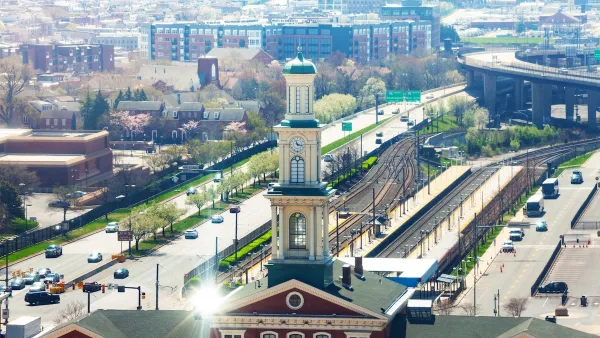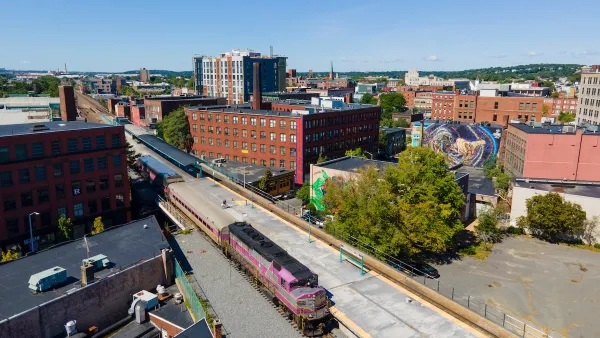In 1996, my professor at the University of Colorado introduced a new concept – Transit Oriented Development (TOD). An emerging group of professionals that included New Urbanists were advocating the idea, but few on-the-ground examples existed. The debate within the planning field during those years focused on the marketability of a mixed-use product. TODs would have to overcome large obstacles. Banks were hesitant to finance an “unproven” product. Developers wondered if they could pass on higher construction costs to buyers, retailers questioned if there would be enough customers to fill their stores, and planners questioned if TODs would lead to changes in travel behavior. A decade later, many continue to ask the same questions about TOD although the difference today is that there are many successful examples to showcase and study. TOD is gaining popularity and widespread appeal but an important unanswered question remains – will TOD remain a niche product or will it become a mainstream development concept?
In 1996, my professor at the University of Colorado introduced a new concept – Transit Oriented Development (TOD). An emerging group of professionals that included New Urbanists were advocating the idea, but few on-the-ground examples existed. The debate within the planning field during those years focused on the marketability of a mixed-use product. TODs would have to overcome large obstacles. Banks were hesitant to finance an "unproven" product. Developers wondered if they could pass on higher construction costs to buyers, retailers questioned if there would be enough customers to fill their stores, and planners questioned if TODs would lead to changes in travel behavior. A decade later, many continue to ask the same questions about TOD although the difference today is that there are many successful examples to showcase and study. TOD is gaining popularity and widespread appeal but an important unanswered question remains – will TOD remain a niche product or will it become a mainstream development concept?
Most Americans live in car dependent locations, not in TODs. In 2000, approximately 15 million Americans (approximately 5 percent) lived within a half-mile of 3,252 fixed-guideway transit stations across the country.[i] That represents 4,600 people per transit precinct, but not all of these are TODs. For example, most successful TODs have a minimum population of 10,000 – 15,000.[ii] There is no single list of TODs in America. A recent study[iii] identified about 100 TODs across the Untied States, but this failed to include many transit precincts which meet the definition of a TOD (compact, mixed-use, and walkable). Subway stations in cities like New York, Boston, and Washington, D.C. were not included on the list.
By any calculation, the supply TODs in America is limited, but the concept is gaining appeal to the masses for a number of reasons, including: more empty nesters, people waiting longer or choosing not to marry, fewer kids, people desiring smaller homes with access to amenities, and increased traffic congestion. TODs also offer financial benefits to residents as well. Studies reveal that households in TODs own fewer cars, therefore a larger percentage of income ends up in an asset (the home) rather than spent on automobiles, which depreciates. Two studies[iv] indicate that up to a third of the population would choose to live in a TOD if the choice existed. If this were true, America would need over 6,000 stations to accommodate this demand.
Levine argues that zoning is the main obstacle to compact, mixed-use development.[v] Building TODs in many cities are illegal and necessitates a lengthy rezoning process. Planners need to understand the time value of money. An uncertain development process is a major concern for developers and investors. Cervero's study revealed that planners ranked expedited development approvals at the bottom of a list of planning tools to promote TOD, whereas developers felt this was the most important tool. More and more governments are changing their zoning, but it remains a major obstacle to a more widespread adoption of TOD in the United States.
Without a major federal, state, and local commitment to building more fixed-route transit stations in the United States, it will be impossible to satisfy the demand for TOD. Because the demand to live near a rail station is higher than the supply, regression models continue to show that land values in station precincts are approximately 8% - 30% above the market, holding all other variables constant. Emerging Trends in Real Estate reports TOD as the top investment prospect because land values appreciate faster in up-markets and hold value better in down-markets.[vi] Until supply catches up with demand, housing prices in TODs will remain higher than the normal market, thus encouraging developers to build more provided they can overcome zoning obstacles.
Denver voters passed FasTracks in November 2004. This project will construct about 60 new stations across the region over the next decade. Assuming local government revises zoning regulations to allow for TOD, this will create an opportunity for up to a million new residents to live within walking distance of train stations. FasTracks will transform Denver from a sprawling region dependent upon the automobile to the Washington, D.C. of the 21st century. Developers are already proposing TODs around a number of stations years from opening.
The most important thing that planners can do is to plan. Planners need to establish a community vision based on local input, create a master plan, and update archaic zoning laws. These actions will set the stage for private investment in TOD. Cities have many tools at their disposal for assembling land and creating tax incentives to encourage development. Local and state agencies responsible for approving land development need to better communicate. The New Jersey Transit Village Initiative is a perfect example where state and local agencies work closely to "prime the pump" for TOD. Local champions (particularly elected officials and planning directors) need to ensure that these projects succeed.
The federal government, metropolitan planning organizations, state government, and cities need to work collaboratively to finance the construction of new rail lines and update zoning laws. If every rail station across the country were to become a TOD there would still be room for an additional 3,000 TODs to meet the current level of demand, not to mention future demand due to population growth.
TOD is a niche development product in the United States, but not because of insufficient demand. People understand the benefits. That is why they pay so much to live there. The reason TOD is not a mainstream product is because our transportation investments and land use policies continue to focus on an automobile-based system. If you think houses in TODs are expensive now, just wait until gasoline hits $7 per gallon.
###
[i] Center for Transit-Oriented Development. 2006. Preserving and Promoting Diverse Transit-Oriented Neighborhoods. Sponsored by the Ford Foundation. [http://www.reconnectingamerica.org/public/reports]
[ii] Newman and Kenworthy recommend a minimum density of 10,000 residents or jobs per TOD. 2006. "Urban Design to Reduce Automobile Dependence," Opolis. Vol. 2, No. 1, pp. 35-51.
[iii] Cervero et al. 2004. Transit-Oriented Development in America: Experiences, Challenges and Prospectus. TCRP Report 102, Transportation Research Board of the National Academies: Washington, D.C. [http://onlinepubs.trb.org/onlinepubs/tcrp/tcrp_rpt_102.pdf]
[iv] Levine and Inam. 2004. "The Market for Transportation-Land Use Integration: Do Developers Want Smarter Growth than Regulations Allow?," Transportation, Vol. 31. No. 4, pp. 409-427.Center for Transit-Oriented Development. 2004. Hidden in Plain Sight: Capturing the Demand for Housing Near Transit. Reconnecting America: Oakland, California. [http://www.reconnectingamerica.org/public/reports]
[v] Levine. 2006. Zoned Out: Regulation, Markets, and Choices in Transportation and Metropolitan Land-Use. RFF Press: Washington, D.C.

Maui's Vacation Rental Debate Turns Ugly
Verbal attacks, misinformation campaigns and fistfights plague a high-stakes debate to convert thousands of vacation rentals into long-term housing.

Planetizen Federal Action Tracker
A weekly monitor of how Trump’s orders and actions are impacting planners and planning in America.

In Urban Planning, AI Prompting Could be the New Design Thinking
Creativity has long been key to great urban design. What if we see AI as our new creative partner?

Portland Raises Parking Fees to Pay for Street Maintenance
The city is struggling to bridge a massive budget gap at the Bureau of Transportation, which largely depleted its reserves during the Civd-19 pandemic.

Spokane Mayor Introduces Housing Reforms Package
Mayor Lisa Brown’s proposals include deferring or waiving some development fees to encourage more affordable housing development.

Houston Mayor Kills Another Bike Lane
The mayor rejected a proposed bike lane in the Montrose district in keeping with his pledge to maintain car lanes.
Urban Design for Planners 1: Software Tools
This six-course series explores essential urban design concepts using open source software and equips planners with the tools they need to participate fully in the urban design process.
Planning for Universal Design
Learn the tools for implementing Universal Design in planning regulations.
Gallatin County Department of Planning & Community Development
Heyer Gruel & Associates PA
JM Goldson LLC
City of Camden Redevelopment Agency
City of Astoria
Transportation Research & Education Center (TREC) at Portland State University
Jefferson Parish Government
Camden Redevelopment Agency
City of Claremont





























